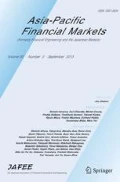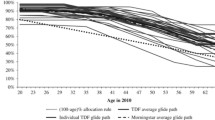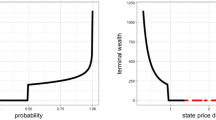Abstract
This study finds a necessary and sufficient condition for mutual fund separation, in which investors have the same portfolio of risky assets regardless of their utility functions. Unlike previous studies, the market condition is obtained in analytic form, using the Clark–Ocone formula of Ocone and Karatzas (Stoch Stoch Rep 34(3–4):187–220, 1991). We also find that the condition for separation among arbitrary utility functions is equivalent to the condition for separation among utility functions with constant relative risk aversion (CRRA utility functions). The condition is that a conditional expectation of an infinitesimal change in the uncertainty of an instantaneous Sharpe ratio maximizing portfolio can be hedged by the Sharpe ratio maximizer itself. In a Markovian market, such an infinitesimal change is characterized as an infinitesimal change in state variables. A closer look at the Clark–Ocone formula offers an intuition of the condition: an investor invests in (1) the Sharpe ratio maximizer; and (2) another portfolio in such a way as to reduce the uncertainty produced by an infinitesimal change in the Sharpe ratio maximizer, depending on four components: the investor’s wealth level, marginal utility and risk tolerance, at the time of consumption, and the shadow price. This decomposition is also valid in non-Markovian markets.
Similar content being viewed by others
Notes
It is defined by
$$\begin{aligned}&\begin{aligned} Y^{0}_{j,t} = \mathsf {1}_{j=0}&+ \int _{0}^tY^0_{j,s}\Big (\lambda ^\top (X_s)\mathrm {d}B_s + (r(X_s) + \lambda ^\top \lambda (X_s))\mathrm {d}s\Big )\\&+ \sum _{k=1}^n\int _0^t Y^k_{j,s} \frac{1}{H_s}\Big (\frac{\partial }{\partial x_k}{\lambda (X_s)^\top } \mathrm {d}B_s +\frac{\partial }{\partial x_{k}} (r(X_s) + \lambda ^\top \lambda (X_s))\mathrm {d}s\Big ), \end{aligned}\\&\begin{aligned} Y^{i}_{j,t} = \mathsf {1}_{j=i}&+ \sum _{k=1}^n\int _0^t Y^k_{j,s} \Big (\frac{\partial }{\partial x_k}{\Sigma ^{X \top }_j(X_s)} \mathrm {d}B_s +\frac{\partial }{\partial x_{k}} \mu ^X_j(X_s)\mathrm {d}s\Big ) \end{aligned} \end{aligned}$$for \(i=1,\dots ,n\) and \(j=0,\dots ,n\).
References
Cass, D., & Stiglitz, J. E. (1970). The structure of investor preferences and asset returns, and separability in portfolio allocation: A contribution to the pure theory of mutual funds. Journal of Economic Theory, 2, 122–160.
Chamberlain, G. (1988). Asset pricing in multiperiod securities markets. Econometrica, 56(6), 1283–1300.
Di Nunno, G., Øksendal, B., & Proske, F. (2009). Malliavin calculus for Lévy processes with applications to finance. Berlin: Springer.
Dokuchaev, N. (2014). Mutual fund theorem for continuous time markets with random coefficients. Theory and Decision, 76(2), 179–199.
Dybvig, P., & Liu, F. (2018). On investor preferences and mutual fund separation. Journal of Economic Theory, 174, 224–260.
Karatzas, I., Lehoczky, J. P., & Shreve, S. E. (1987). Optimal portfolio and consumption decisions for a “small investor” on a finite horizon. SIAM Journal on Control and Optimization, 25(6), 1557–1586.
Karatzas, I., & Shreve, S. E. (1991). Brownian motion and stochastic calculus (2nd ed.). Berlin: Springer.
Merton, R. C. (1973). An intertemporal capital asset pricing model. Econometrica, 41(5), 867–887.
Nielsen, L. T., & Vassalou, M. (2006). The instantaneous capital market line. Economic Theory, 28(3), 651–664.
Nualart, D. (2006). The Malliavin calculus and related topics (2nd ed.). Berlin: Springer.
Ocone, D. L., & Karatzas, I. (1991). A generalized clark representation formula, with application to optimal portfolios. Stochastics and Stochastics Reports, 34(3–4), 187–220.
Schachermayer, W., Sîrbu, M., & Taflin, E. (2009). In which financial markets do mutual fund theorems hold true? Finance and Stochastics, 13(1), 49–77.
Skiadas, C. (2009). Asset pricing theory. Princeton: Princeton University Press.
Stoyanov, J. M. (2013). Counterexamples in probability (3rd ed.). New York: Dover.
Acknowledgements
The author thanks Koichiro Takaoka, Toshihiro Yamada, Hisashi Nakamura and Hideyuki Takamizawa for insightful discussions. The author also thanks anonymous referee for constructive comments.
Author information
Authors and Affiliations
Corresponding author
Additional information
This work is supported by The Fee Assistance Program for Academic Reviewing of Research Papers (for Graduate Students, Hitotsubashi University).
Rights and permissions
About this article
Cite this article
Igarashi, T. An Analytic Market Condition for Mutual Fund Separation: Demand for the Non-Sharpe Ratio Maximizing Portfolio. Asia-Pac Financ Markets 26, 169–185 (2019). https://doi.org/10.1007/s10690-018-9261-6
Published:
Issue Date:
DOI: https://doi.org/10.1007/s10690-018-9261-6




